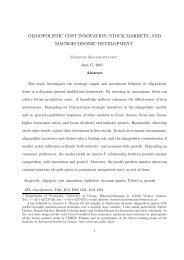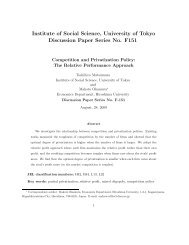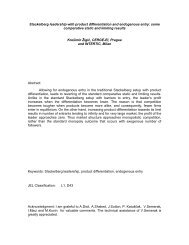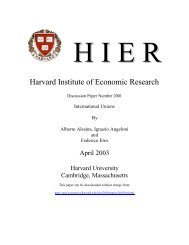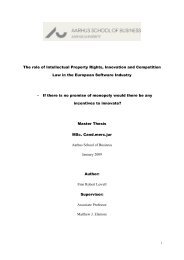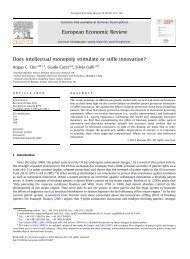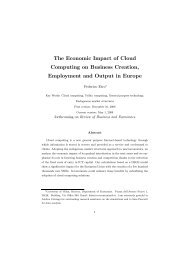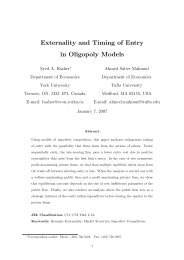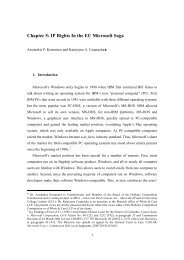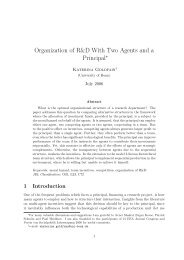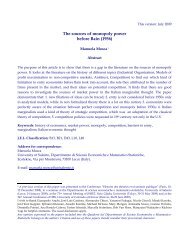The EU Approach to Abuse of Dominance - Intertic
The EU Approach to Abuse of Dominance - Intertic
The EU Approach to Abuse of Dominance - Intertic
You also want an ePaper? Increase the reach of your titles
YUMPU automatically turns print PDFs into web optimized ePapers that Google loves.
Economy, competition is dynamic and innova<strong>to</strong>rs conquer large parts <strong>of</strong> a market, so that any static<br />
analysis <strong>of</strong> market shares cannot say anything about dominance. In other words, a market can be<br />
currently dominated by a single firm, but if many other firms which are not even active in this market<br />
are investing in R&D <strong>to</strong> enter in<strong>to</strong> it, as it happens in many high-tech sec<strong>to</strong>rs, this market is<br />
substantially competitive in a dynamic sense. Nevertheless, any leader in such a competitive winnertakes-all<br />
market would be always characterized as dominant by the static and market-share-based<br />
approach <strong>of</strong> the Discussion Paper.<br />
Moreover, modern economic theory tells us that in these dynamic sec<strong>to</strong>rs market leaders, as<br />
long as they are constrained by effective competition in the market for innovations, invest more than<br />
their competi<strong>to</strong>rs and hence are more likely <strong>to</strong> remain leaders. 8 In this sense, statements saying that<br />
“high market shares, which have been held for some time, indicate a dominant position” can be true in<br />
some sec<strong>to</strong>rs, but not in high-tech sec<strong>to</strong>rs with competition for the market. In conclusion, the general<br />
impression is that there is an excessive stress on the importance <strong>of</strong> market shares <strong>to</strong> evaluate<br />
dominance, and that this can be highly misleading especially for dynamic markets.<br />
<strong>The</strong> part on barriers <strong>to</strong> expansion and entry (# 34-40) concerns a concept which is far from<br />
unambiguous in economic theory. <strong>The</strong> definition <strong>of</strong> these barriers as “fac<strong>to</strong>rs that make entry<br />
impossible or unpr<strong>of</strong>itable while permitting established undertakings <strong>to</strong> charge prices above the<br />
competitive level” (# 38) applies well <strong>to</strong> legal barriers but not <strong>to</strong> other fac<strong>to</strong>rs which are sometimes<br />
seen as barriers. For instance, high fixed costs <strong>of</strong> production and R&D or investments needed <strong>to</strong><br />
develop network externalities or learning by doing advantages, do not make entry impossible: the<br />
correct definition in these cases would be that these fac<strong>to</strong>rs endogenously limit entry or endogenously<br />
determine how many and which firms pr<strong>of</strong>itably enter. <strong>The</strong> difference is not just in the definition but<br />
also in the economic consequence, since modern economic theory has shown that when entry is<br />
impossible market leaders may behave in an anti-competitive way, but when entry is constrained by<br />
technological or demand conditions they (always) behave in a pro-competitive way even if the cited<br />
fac<strong>to</strong>rs limit entry and the market leaders obtain high market shares.<br />
2. <strong>The</strong> principles <strong>of</strong> <strong>EU</strong> antitrust<br />
Despite the Discussion Paper claims that “the purpose <strong>of</strong> Article 82 is not <strong>to</strong> protect<br />
competi<strong>to</strong>rs from dominant firms’ genuine competition based on fac<strong>to</strong>rs such as higher quality, novel<br />
products, opportune innovation or otherwise better performance, but <strong>to</strong> ensure that these competi<strong>to</strong>rs<br />
8 See Etro (2004, “Innovation by Leaders”, Economic Journal, Vol. 114, 495, April, pp. 281-310).<br />
5



